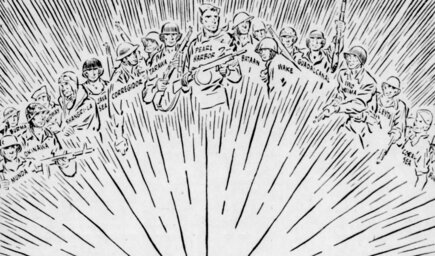Starting things off with a surprising strip from VJ Day, August 15, 1945.
Given the normal distribution channels of the time and the fact that there’s no day specified in the margins, I’m going to assume that, with the war winding down, Roy Crane recognized the strong possibility of a Japanese surrender before his story are could play out.
My guess is that the strip was sent out with instructions to run it if Japan surrendered, probably with some kind of wire reminder when that happened. As far as I could see, other strips just kept to schedule, acknowledging peace two weeks or so later.
Good on you, Roy Crane!
Political cartoonists, then as now, worked on a less leisurely schedule. Henry Barrow’s piece ran in several papers on August 15, and the detail suggests that it was sketched up and ready to send as soon as the peace agreement was signed.
It’s important to remember that, while time had been running out for Japan, there was an active resistance to surrendering within their government, so that while peace was on the table, it was not a certainty and a lot of American GIs had come home from the European Theater with orders to prepare for an invasion.
Victory seemed likely, but the cost remained very much in question.
Barrow also had this celebratory cartoon in several papers, and he wasn’t the only cartoonist with multiple credits on August 15.
Dorman Smith also had several VJ Day cartoons in various papers, this one expressing the joy Americans felt over the victory.
There’s no doubt that racism played a major role in how victory in the Pacific was seen, but, then again, anger was natural: Japanese occupation of conquered territories had not been gentle.
Buescher employs the standard Asian stereotype that had been employed in cartoons and movies throughout the war. He also factors in the atomic bomb, which had been dropped six days before the surrender.
Juxtaposition of the Day
Little was yet known about the bomb and atomic power generally, but both Manning and Buescher foresaw the new challenge it brought to the world. Manning treated the matter with grim humor, Buescher played it straight, but both acknowledged that the world had changed.
Juxtaposition of the Day #2
Not all the cartoons on August 15 celebrated the end of the war: Pratt and Thomas warned about what they saw as a failure to anticipate the shift to a peacetime economy.
It was a reasonable fear, given how much of America’s industries had been turned to support of the war effort, even before our entry into the fray. It was more than the fact that weapons factories had sprung up to employ Rosie the Riveter; automobile and appliance makers had also converted into producing materials for the war.
There was also a problem in that returning GIs were legally guaranteed their jobs back, which could be a problem if more than one young man had passed through and then been drafted, and it created a particular problem for women who had been hired and were now being laid off to make room for returning veterans.
While factories retooled and tried to deal with re-staffing issues, Ohio Bell promised to return to production of civilian-style telephones, given that the units they’d been building for the military were not compatible with the existing system.
Note that, while this ad ran August 15, its wording, and the War Bonds message in the margin, indicate that it had been running earlier as the company began to plan to return to peacetime production.
Meanwhile, in Alaska:
Heller treads on cultural grounds, but does so in a prelude to the meeting between Donald Trump and Vladimir Putin in Anchorage today, and the absence of Volodymyr Zelenskyy.
Davey is considerably more direct in expressing his feelings about the two having left Zelenskyy out of the negotiations.
And Moudakis suggests an imbalance between the realty TV star and his KGB-trained counterpart. He’s not the only observer to cast doubt on Trump’s repeated claims of friendship with Putin, and to suggest that the Russian is indulging Dear Leader’s cheerful pride in negotiating.
Luckovich gets a laugh with this picture of the impossible challenge facing Putin’s translator, but he raises a serious point about Trump’s increasingly erratic lack of focus, which was evident in his recent talks in the EU as well as in his rambling speeches and answers to the press. He’s always been prone to going off script, but recently he seems to completely lose track of the topic at hand.
Adding Trump’s established unwillingness to comply with standard documentation of meetings and Luckovich isn’t far off in wondering if any coherent discussions will emerge from this meeting, while other observers wonder what Dear Leader will give away to the former intelligence officer in his quest to have a peace agreement, or what he can claim as one.

Finally, to return to VJ Day, here’s a gag Jeff Keane unveiled at the Kenosha Comics Festival in 2014.
Seems his dad, Bil, was cartooning for Stars and Stripes and had the good fortune that his cartoons and Bill Mauldin’s cartoons were in an anchored position, such that, a few weeks after the war ended, he was able to count on this visual joke working, knowing that Mauldin was doing cartoons about soldiers being back home.
The GIs in Bil’s cartoon are still deployed, but can see Mauldin’s ex-GI across the way. Being sent home was a matter of getting a certain number of points for what you’d been through, and he’s saying “If we had 80 more points, we’d be over there in Mauldin’s cartoon.”
Not that Mauldin’s man was exactly coming home to open arms: “Hello, Suzy … I WONDERED why ya broke off our engagement while I was in Sicily.”
So it goes, pal. But other sweethearts had been singing this song:
